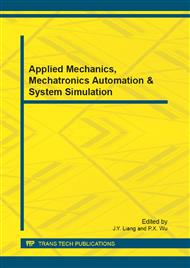p.922
p.927
p.932
p.936
p.942
p.948
p.954
p.958
p.962
Model and Simulation of the Brain Scalp Potential Analysis
Abstract:
Based on spherical head models, this paper, by employing the finite element method (FEM), analyzes the potential distribution of the brain scalp surface and attempts to work out the electroencephalography (EEG) forward problem, in hope of finding out the impact the dipole parameters has on it. According to the electromagnetism theory, this paper discusses the general resolution of EEG, it requires electric potentials of the globe's surface, and graphically displays results of computation through finite element post-processing, which tests their effectiveness. Furthermore, it analyzes the influences of dipole parameters on the potential distribution of scalp surface, such as position, direction and strength, which attempts to provide an effective method to solve EEG forward problem, based on diversified head model, and also proposes a prior information to the solution to EEG inverse problem.
Info:
Periodical:
Pages:
942-947
Citation:
Online since:
September 2012
Authors:
Keywords:
Price:
Сopyright:
© 2012 Trans Tech Publications Ltd. All Rights Reserved
Share:
Citation:


